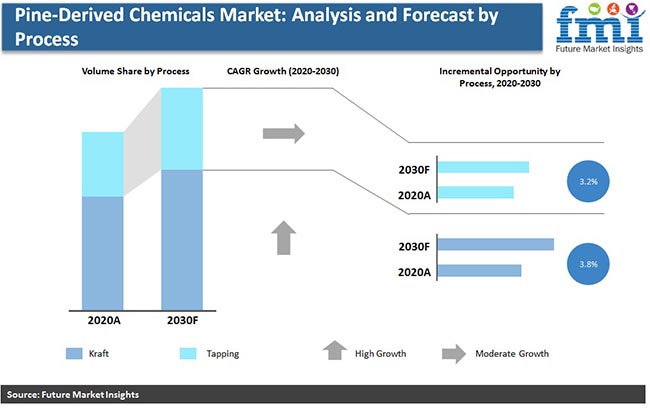The global pine-derived chemicals market size is expected to reach US$ 7.7 Bn by the end of 2030. According to a study by Future Market Insights (FMI), the market will show a steady rise at 4.3% CAGR between 2020 and 2030. According to the report, growing opportunities in the packaging ink sector along with the adoption of environmentally friendly inks will drive the size of the market for ink printing. While the world’s companies nowadays shift towards the use of emission-free, environmentally friendly materials in their processes, growth in this market is sure. The report offers a comprehensive overview of the market, covering key growth drivers, restraints, opportunities, and prevailing trends. It uses unique research methods to offer the most accurate analysis of the market.
For Information On The Research Approach Used In The Report, Ask Analyst @ https://www.futuremarketinsights.com/ask-question/rep-gb-1355
It includes in-depth insights into the pine-derived chemicals market. Some of these are:
- The estimated value of the market was at US$ 5 Bn in 2020. Through the course of the report’s forecast period, the market is exhibited to show a steady pace of growth.
- The pine-derived chemicals market is primarily driven by its widespread usage in the areas of construction, printing and publishing, cleaning products, paper and a number of other industrial activities.
- In the last few years North America has dominated the overall market.
- The United States has a significant number of pine tree plantations, and thus has the highest share.
- The Asia Pacific market is powered by rising understanding of environmentally friendly goods and substantial efforts to reduce global carbon footprint.
- In terms of process, the kraft segment leads the market and is likely to remain dominant through the course of the report’s forecast period.
“Increasing environmental concern due to increasing carbon emissions from products derived from petroleum oil and natural gas has contributed to a substantial rise in demand for chemicals derived from environmentally friendly pine oil. Increasing use of these goods leads to decreased carbon dioxide emissions and carbon footprints,” said a lead analyst at FMI.

Poor Logistics Resulted Due to COVID-19 Outbreak will Affect Supply Disruptions
Pine-derived chemicals have historically been used amongst others chemicals in the adhesive industry, the building industry and the healthcare sector. In the recent past, they have found applications in applications in printing inks, adhesives, soaps & detergents, resins, plasticizers, surface coatings, fragrance chemicals among others. Pine chemicals are obtained by distilling resin and fatty oil extracts that are semi-solid. Pine-based products are mainly produced from gums, stumps and Kraft Pulp products. They include rosin, high oil, turpentine, resin and so forth.
Factors such as poor logistics due to traffic control and restrictions on public movement are affecting the market for pine-derived chemicals since these restrictions are causing disruptions in supply. While this may not affect the pine industry’s requirements in the short term, extended trade restrictions can have a significant impact on this industry, prompting companies to explore alternative sourcing partners. Increasing population coupled with increasing economic standards has led to increased spending on food services. Contrary to the aforementioned forecasts, however, the market may head to tough waters.
Who is Winning?
Key players operating in the market are Eastman Chemical Company, Harima Chemicals Group, Inc., Arakawa Chemical Industries, Ltd., Kraton Corporation, and Forchem Oyj. Strong government rules and regulations along with price competition between different manufacturers of pine derived chemicals are restricting the market. Limited supply of trees may threaten the competitiveness of the industry and may impact the market price trend for pine related chemicals. Additionally, mergers and acquisitions continue to be a popular strategy among market players.
Get Valuable Insights into Pine-Derived Chemicals Market
Future Market Insights, in its new report, presents an unbiased analysis of the global pine-derived chemicals market, covering historical demand data and forecast figures for the period between 2020 and 2030. The study divulges compelling insights into growth witnessed in the market. In terms of application, the global pine-derived chemicals market has been divided into paints & coatings, adhesives & sealants, surfactants, and printing inks. Based on type, the market has been segmented into tall oil fatty acids, tall oil rosin, gum turpentine, gum rosin, pitch, sterols, and others. Regionally, the market can be segmented into North America, Latin America, Europe, East Asia, South Asia, Oceania and MEA.
For more insights into the market, request a sample of this report@ https://www.futuremarketinsights.com/reports/sample/rep-gb-1355
PINE-DERIVED CHEMICALS MARKET TAXONOMY
The global Pine- Derived Chemicals Market is segmented in detail to cover every aspect of the market and present complete market intelligence to readers
Source
- Living trees
- Dead pine stumps & logs
- By-Products of sulphate
Application
- Adhesives & sealants
- Paints & Coatings
- Surfactants
- Printing inks
- Others
Type
- Tall oil fatty acid
- Tall oil rosin
- Gum turpentine
- Gum rosin
- Pitch
Process
- Kraft
- Tapping

